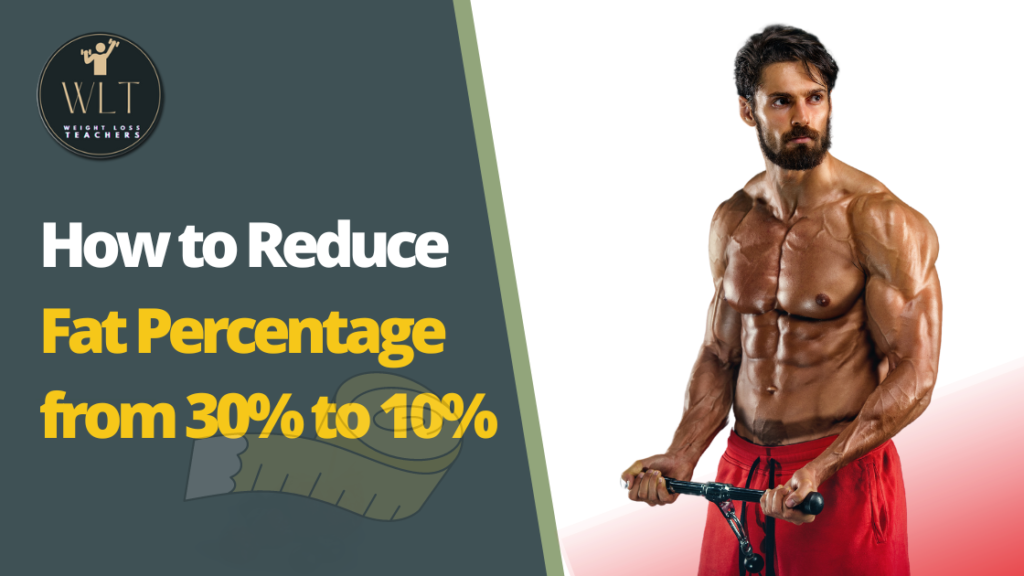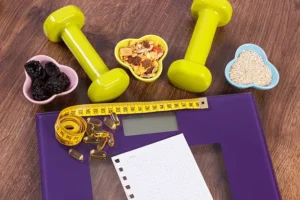
How to Reduce Body Fat Percentage from 30% to 10%

Achieving the elusive goal of simultaneously building muscle and losing fat is a fitness Holy Grail for many individuals. It’s often referred to as “body recomposition” and represents a challenging but attainable fitness objective. The conventional wisdom suggests that you need to go through bulking and cutting phases separately, but recent advances in fitness science and nutrition have shown that it’s possible to make progress in both directions simultaneously.
Table of Contents
Introduction
The conventional wisdom suggests that you need to go through bulking and cutting phases separately, but recent advances in fitness science and nutrition have shown that it’s possible to make progress in both directions simultaneously. This article aims to guide you through the steps to build muscles and lose fat at the same time, enabling you to transform your body effectively and efficiently.

Understanding the Basics of Building Muscle and Losing Fat

Before embarking on your journey to simultaneously build muscle and lose fat, it’s imperative to grasp the fundamental principles that underlie these two distinct yet interconnected processes. Building muscle and losing fat are at the core of most fitness goals, but they require different approaches. Let’s delve deeper into these concepts:
Building Muscle
Muscle growth, scientifically known as hypertrophy, is the result of your muscles adapting to resistance training. When you engage in resistance exercises, such as lifting weights or performing bodyweight exercises like push-ups and squats, you subject your muscles to stress. This stress induces tiny tears, called micro-tears, in the muscle fibers. It might sound counterintuitive, but these micro-tears are crucial for muscle growth.
After your workout, during the recovery phase (which happens mostly when you rest and sleep), your body springs into action. It repairs and reinforces these damaged muscle fibers, making them thicker and stronger than before to better handle the stress they were subjected to. This process is called muscle protein synthesis, and it’s the foundation of muscle growth. To promote this growth, it’s essential to progressively increase the resistance in your workouts, challenging your muscles to adapt continually.
Losing Fat
Fat loss, on the other hand, is primarily a matter of energy balance. It revolves around the concept of creating a calorie deficit, wherein you consume fewer calories than your body expends. When your body faces a calorie deficit, it turns to its energy reserves, which are stored in the form of fat, to bridge the gap. Consequently, fat cells release stored fatty acids, which are then metabolized to provide the energy your body needs for its daily functions.
A sustainable calorie deficit can be achieved through a combination of dietary adjustments and increased physical activity. Managing your calorie intake, incorporating cardiovascular exercise, and strength training all play vital roles in creating the necessary calorie deficit for fat loss.
Therefore, building muscle and losing fat are distinct processes with their own mechanisms. Building muscle involves resistance training and muscle protein synthesis, while fat loss centers on achieving a calorie deficit. To successfully pursue both goals concurrently, you’ll need a well-rounded approach that balances nutrition, strength training, cardiovascular exercise, and consistent tracking of your progress. With a solid understanding of these fundamentals, you’re better equipped to embark on your journey towards a stronger, leaner, and healthier you.
Understanding Your Caloric Needs: BMR and TDEE

Achieving the delicate balance of building muscle while losing fat requires a fundamental understanding of your body’s energy requirements. Two crucial concepts in this regard are Basal Metabolic Rate (BMR) and Total Daily Energy Expenditure (TDEE).
Basal Metabolic Rate (BMR)
Your BMR represents the number of calories your body requires to maintain its basic functions while at rest. This includes functions like breathing, circulating blood, regulating body temperature, and repairing cells. Calculating your BMR is the first step in determining your daily calorie needs.
Several factors influence your BMR, such as your age, gender, weight, and height. Thankfully, there are numerous online calculators and equations, such as the Harris-Benedict equation, that can provide a reasonably accurate estimate of your BMR. These calculators consider your basic physiological characteristics to estimate the number of calories your body needs when you’re at complete rest.
Total Daily Energy Expenditure (TDEE)
While your BMR represents your calorie needs at rest, it’s only the starting point. To determine the actual number of calories you should consume each day, you must factor in your activity level. This is where your TDEE comes into play. TDEE accounts for the calories you burn through daily activities, exercise, and the thermic effect of food (the energy your body expends to digest and metabolize the food you eat).
To calculate your TDEE, you’ll need to estimate how active you are on a daily basis. The commonly used activity levels range from sedentary (little to no exercise) to highly active (intense exercise or physical labor). By multiplying your BMR by an activity factor that corresponds to your lifestyle, you can arrive at a fairly accurate estimate of your TDEE.
Creating a Calorie Deficit
Once you’ve determined your TDEE, the next step is to create a calorie deficit. A calorie deficit is essential for fat loss, as it prompts your body to utilize stored fat for energy. A moderate calorie deficit of approximately 300-500 calories below your TDEE per day is often recommended for gradual and sustainable fat loss while preserving muscle mass.
However, it’s crucial to strike the right balance. Too large of a calorie deficit can lead to muscle loss, while too small of a deficit may result in slow or negligible fat loss. Therefore, it’s essential to monitor your progress closely, adjust your calorie intake as needed, and consult with a registered dietitian or fitness professional for personalized guidance.
Planning Your Nutrition for Simultaneous Muscle Building and Fat Loss
Proper nutrition is the linchpin of achieving the twin goals of building muscle and losing fat simultaneously. Your diet not only fuels your workouts but also provides the raw materials necessary for muscle growth while ensuring you maintain a calorie deficit for fat loss. Let’s delve into the crucial aspects of planning your nutrition carefully to help you on your journey.
Prioritize Protein

Protein is the cornerstone of any diet geared towards muscle building and fat loss. It serves as the primary building block for muscle tissue and plays a crucial role in muscle repair and growth. Without an adequate protein intake, your muscles won’t have the necessary materials to recover and grow.
To ensure you’re getting enough protein, aim for a daily intake ranging from 1.2 to 2.2 grams per kilogram of body weight. This range can accommodate individual differences in metabolism, activity level, and goals. For instance, if you’re engaging in intense resistance training, aiming for the higher end of this range may be more suitable.
When selecting protein sources, opt for lean options like chicken, turkey, lean beef, fish, and low-fat dairy products. For those following a plant-based diet, excellent sources of protein include legumes, tofu, tempeh, and a variety of nuts and seeds. Whey protein supplements can also be a convenient way to meet your protein needs, especially post-workout when rapid protein absorption is beneficial.
Moderate Carbohydrates
Carbohydrates are a vital energy source, particularly during high-intensity workouts. However, their role in fat loss and muscle preservation is more complex. While carbs are essential for fueling your workouts and maintaining performance, excessive carb consumption can hinder fat loss, especially if your body doesn’t utilize the excess energy.
To strike the right balance, focus on consuming complex carbohydrates like whole grains, fruits, and vegetables. These provide a sustained release of energy and are packed with essential nutrients. Fiber-rich carbohydrates also help you feel full and satisfied, reducing the likelihood of overeating.
Adjust your carbohydrate intake based on your energy needs. On workout days, prioritize carbs around your training sessions to maximize performance. On rest days, you can reduce your carb intake slightly since you won’t require as much immediate energy.
Healthy Fats
While carbohydrates and protein are more directly associated with muscle growth, healthy fats play a crucial role in overall health and hormonal regulation. Include sources of healthy fats like avocados, nuts, seeds, and olive oil in your diet. These fats are essential for the absorption of fat-soluble vitamins (A, D, E, and K), and they also support the production of hormones, including those involved in muscle growth and fat loss.
Don’t fear dietary fat; it’s a valuable component of your nutrition plan. However, be mindful of portion sizes, as fats are calorie-dense. A moderate amount of healthy fats can help you feel satisfied and provide a sense of satiety in your meals.
Manage Calories
To simultaneously build muscle and lose fat, you need to create a calorie deficit. This means consuming fewer calories than your body needs to maintain its current weight. You can achieve this deficit by monitoring your calorie intake.
Start by determining your Total Daily Energy Expenditure (TDEE), as discussed earlier. Once you know your TDEE, aim to consume around 300-500 calories below this value per day. This calorie deficit should be sufficient to promote gradual fat loss while preserving muscle mass. Avoid extreme calorie restrictions, as they can lead to muscle loss and other adverse health effects.
Using food tracking apps or consulting with a registered dietitian can be invaluable tools to help you monitor your calorie intake accurately. These resources can help you stay on track and make informed decisions about your dietary choices.
Meal Timing
Meal timing can be a strategic tool to optimize your nutrition for simultaneous muscle building and fat loss. Two popular strategies include intermittent fasting and carb cycling:
- Intermittent Fasting: This approach involves cycling between periods of eating and fasting. The fasting periods can range from 16 hours of fasting with an 8-hour eating window to more extended fasts. Intermittent fasting can help control insulin levels, improve nutrient partitioning (the way your body uses nutrients), and enhance fat burning.
- Carb Cycling: Carb cycling involves varying your carbohydrate intake on different days to match your energy needs. On high-intensity workout days, you consume more carbohydrates to fuel your training sessions. On lower activity or rest days, you reduce your carb intake. This strategy can help you optimize energy availability for workouts while still promoting fat loss on lower activity days.
When implementing meal timing strategies, it’s essential to listen to your body and adjust as needed. These approaches may not suit everyone, and individual responses can vary. It’s crucial to prioritize consistency and sustainability in your nutrition plan.
Focus on Strength Training: Building Muscle While Losing Fat

Strength training, often referred to as resistance training, is the bedrock of any successful endeavor to simultaneously build muscle and lose fat. This form of exercise involves using resistance, such as weights, resistance bands, or your body weight, to challenge your muscles. When performed strategically, it can reshape your physique, enhance muscle definition, and facilitate fat loss. Here, we delve into the key principles of effective strength training to help you achieve your fitness goals.
Progressive Overload: The Key to Muscle Growth
Progressive overload is the central tenet of strength training for building muscle. This principle involves continually increasing the resistance or weight you lift over time to challenge your muscles and stimulate growth. In essence, your muscles adapt to the stress you impose on them by growing stronger. To keep the muscle-building process ongoing, you must progressively increase the demands placed on your muscles.
To implement progressive overload effectively:
- Increase Resistance: Gradually increase the weight or resistance in your workouts. For example, if you’re lifting weights, aim to lift slightly heavier weights or do more repetitions with the same weight as you become stronger.
- Adjust Repetitions and Sets: Alter the number of sets and repetitions you perform. For instance, you can start with three sets of 10 repetitions and progress to four sets of 12 repetitions as you advance.
- Shorten Rest Periods: Reducing the rest intervals between sets can intensify your workouts, challenging your muscles further.
- Vary Exercises: Introduce new exercises or variations to keep your workouts fresh and continually shock your muscles with novel challenges.
Compound Exercises: Efficiency and Muscle Activation
Compound exercises are a cornerstone of strength training for several reasons. These exercises involve multiple muscle groups and joints, making them incredibly efficient for building muscle and burning calories. Some key compound exercises include squats, deadlifts, bench presses, rows, and overhead presses.
The benefits of compound exercises include:
- Muscle Activation: Compound movements engage a wide array of muscles, promoting overall muscle development and functional strength.
- Calorie Burn: These exercises require more energy due to their complexity, leading to a higher calorie burn both during and after the workout.
- Time Efficiency: Incorporating compound exercises allows you to work multiple muscle groups in one session, saving you time in the gym.
- Hormonal Response: Compound exercises stimulate the release of hormones like testosterone and growth hormone, which are instrumental in muscle growth and fat loss.
When integrating compound exercises into your strength training routine, ensure you perform them with proper form to reduce the risk of injury and maximize their effectiveness.
Balanced Workout Plan: Targeting Major Muscle Groups

To create a balanced physique and optimize muscle development, it’s essential to target all major muscle groups during your strength training workouts. These major muscle groups include:
- Chest: Targeted with exercises like bench presses and push-ups.
- Back: Strengthened through exercises such as rows, pull-ups, and lat pulldowns.
- Legs: Worked with squats, lunges, leg presses, and deadlifts.
- Shoulders: Developed with overhead presses, lateral raises, and front raises.
- Arms: Engaged with bicep curls and tricep extensions.
- Core: Strengthened through exercises like planks, Russian twists, and leg raises.
A well-rounded workout plan should include exercises that address each of these muscle groups. Neglecting any major muscle group can lead to muscle imbalances and hinder your progress towards a symmetrical and aesthetically pleasing physique.
Rest and Recovery: Muscles Grow During Rest
While intense workouts are essential for muscle stimulation, the actual muscle growth occurs during the rest and recovery phase. When you strength train, you create tiny micro-tears in your muscle fibers. It’s during the recovery period that your body repairs and rebuilds these muscle fibers, making them thicker and stronger.
To optimize muscle recovery:
- Aim for Adequate Sleep: Sleep is crucial for muscle repair and growth. Strive for 7-9 hours of quality sleep each night.
- Incorporate Rest Days: Allow your muscles sufficient time to recover between workouts. Avoid working the same muscle group on consecutive days. A general guideline is to aim for 48 hours of rest before training the same muscle group again.
- Active Recovery: On rest days, consider low-intensity activities like walking, yoga, or swimming to promote blood flow and alleviate muscle soreness.
- Nutrition: Ensure your diet supports recovery by providing the necessary nutrients, including protein, carbohydrates, and healthy fats.
- Hydration: Stay well-hydrated to aid in the transportation of nutrients to your muscles and the removal of waste products.
- Stretching and Mobility Work: Incorporate stretching and mobility exercises to improve flexibility and reduce the risk of injury.
Remember that adequate rest and recovery are just as vital as your actual workouts. Overtraining can lead to fatigue, injury, and impaired progress, so prioritize your recovery to achieve the best results.
Note: There might be affiliate links mentioned here. We may receive a commission if you purchase a product through an affiliate link. There is no additional charge for you. Please do your own research before making any online purchases.
Incorporate Cardiovascular Exercise: Enhancing Fat Loss and Overall Health

While strength training forms the cornerstone of muscle growth, cardiovascular exercise plays a pivotal role in your quest to build muscle and lose fat simultaneously. Cardiovascular workouts help you torch calories, improve your cardiovascular health, and enhance overall fitness levels. To maximize the effectiveness of your fitness routine, consider incorporating both moderate-intensity and high-intensity interval training (HIIT) sessions.
Moderate-Intensity Cardio: The Steady Burn
Moderate-intensity cardio exercises, such as brisk walking, cycling, or swimming, offer a consistent calorie burn over an extended period. These workouts are excellent for improving endurance, cardiovascular health, and fat oxidation. Engaging in moderate-intensity cardio for 30-60 minutes several times a week can help create a calorie deficit, which is crucial for fat loss.
These workouts are particularly effective when performed in a fasted state or after your strength training sessions. In these scenarios, your body is more likely to utilize stored fat for energy, supporting your fat loss goals while preserving muscle tissue.
High-Intensity Interval Training (HIIT): Turbocharge Fat Loss
HIIT is a time-efficient and potent form of cardiovascular exercise that alternates short bursts of intense effort with brief recovery periods. This approach not only elevates your heart rate but also boosts your metabolism, leading to a higher calorie burn both during and after your workout.
The beauty of HIIT is that it can be adapted to various forms of exercise, including sprinting, cycling, jumping exercises, or bodyweight movements like burpees. These high-intensity intervals push your cardiovascular system to the limit, spurring significant calorie expenditure in a short amount of time.
HIIT is particularly effective for fat loss because it promotes excess post-exercise oxygen consumption (EPOC), also known as the “afterburn” effect. After a HIIT session, your body continues to burn calories as it works to return to its pre-exercise state, sometimes for hours or even days afterward.
Balancing Cardio with Strength Training
To achieve the simultaneous goals of building muscle and losing fat, it’s crucial to strike a balance between cardiovascular exercise and strength training. While cardio helps create a calorie deficit necessary for fat loss, strength training maintains and enhances your muscle mass, ensuring that the weight you lose predominantly comes from fat.
Consider scheduling your cardio sessions on days when you’re not performing intense strength training workouts or on separate time slots from your strength sessions. This approach allows your muscles to recover adequately between strength sessions while still promoting fat loss through cardio.
Ultimately, the combination of strength training and cardiovascular exercise provides a well-rounded fitness routine that boosts both muscle growth and fat loss. It’s essential to tailor your cardio regimen to your fitness level and preferences, gradually increasing the intensity and duration as you progress. By incorporating both moderate-intensity and HIIT workouts strategically, you’ll harness the power of cardiovascular exercise to sculpt a leaner, fitter, and healthier you.
Tracking Your Progress: The Roadmap to Success in Simultaneous Muscle Building and Fat Loss

When you embark on the challenging but rewarding journey of simultaneously building muscle and losing fat, diligent tracking of your progress becomes your compass. It provides valuable insights into your fitness endeavors, ensuring that you stay on the right path toward achieving your desired physique. Here’s how you can effectively track your progress on this transformative journey:
Take Measurements: Quantify Change
Measuring specific areas of your body is a practical and reliable way to assess your progress beyond what the scale reveals. Key areas to measure include your waist, hips, chest, arms, and thighs. Regularly taking these measurements allows you to track changes in your body composition over time.
Why Measurements Matter:
- Precision: Measurements offer a precise way to track changes in your body’s dimensions. Even small reductions in body fat or gains in muscle can be accurately recorded.
- Motivation: Seeing tangible progress in the form of decreased waist circumference or increased arm size can be highly motivating and reinforce your commitment to your fitness goals.
- Comprehensive Assessment: Unlike the scale, which measures overall weight, body measurements provide a more holistic view of your body’s transformation. You can identify which areas are responding well to your efforts and which might need more attention.
To effectively track your progress through measurements:
- Use a flexible tape measure to ensure accurate and consistent readings.
- Measure the same areas every time, ideally under similar conditions (e.g., in the morning before eating).
- Record your measurements at regular intervals, such as every two weeks or once a month, to observe trends over time.
Body Composition Analysis: Beyond the Surface
While body measurements provide valuable insights, body composition analysis delves deeper into your progress by assessing changes in your body fat percentage and muscle mass. Several tools and methods are available for this purpose:
- Skinfold Calipers: Skinfold calipers measure the thickness of subcutaneous fat at specific sites on your body, typically at the triceps, suprailiac, abdominal, and thigh areas. These measurements can be used to estimate your body fat percentage.
- DEXA Scan: Dual-energy X-ray absorptiometry (DEXA) is a highly accurate method for measuring body fat percentage, bone density, and lean mass. It provides a comprehensive and detailed analysis of your body composition.
- Bioelectrical Impedance Scales: These scales send a low-level electrical current through your body and measure the impedance (resistance) to estimate your body fat percentage. While not as precise as DEXA, they provide a convenient at-home option for tracking changes in body composition.
Why Body Composition Analysis Matters:
- Precision: Body composition analysis provides a more accurate assessment of changes in body fat and muscle mass compared to measurements alone.
- Adjustments: Knowing your body fat percentage can help you make informed adjustments to your nutrition and training plan. For example, if your body fat percentage remains high, you may need to tweak your calorie intake or adjust your cardio routine.
- Validation: Body composition analysis can validate your progress. If you’re gaining muscle and losing fat, you should see a reduction in body fat percentage over time.
- Motivation: Like measurements, tracking body composition changes can be motivating, especially when you see a decrease in body fat percentage or an increase in lean muscle mass.
Consider incorporating body composition analysis into your tracking routine at regular intervals, such as every few months, to get a more comprehensive view of your progress.
Keep a Workout Journal: The Strength Tracker
![]()
A workout journal serves as your fitness diary, documenting your training journey and providing insight into your strength gains and workout patterns. To keep an effective workout journal:
- Record Exercises: Write down the exercises you perform during each workout session. Include details like the type of exercise, number of sets, and repetitions.
- Log Weights: Record the weights or resistance levels you use for each exercise. Tracking weight increases over time is a powerful indicator of muscle strength and growth.
- Note Progression: Document your progress in terms of lifting more weight, completing more repetitions, or mastering advanced variations of exercises.
- Record Rest Periods: Keeping track of rest periods between sets can help you manage the intensity of your workouts and ensure you’re challenging yourself appropriately.
- Track Workouts: Document the date and time of each workout. This allows you to establish a workout routine and monitor consistency.
Why Keeping a Workout Journal Matters:
- Accountability: A workout journal holds you accountable to your fitness plan, helping you stay committed to your goals.
- Identification of Plateaus: If you notice a plateau in your strength gains, your workout journal can help identify trends or potential areas for improvement.
- Adjustments: Reviewing your journal enables you to make informed adjustments to your training program, such as increasing weight or changing exercise selection.
- Motivation: Reflecting on your progress, no matter how small, can provide motivation and reinforce your dedication to your fitness journey.
Whether you use a physical notebook, a fitness app, or an online spreadsheet, maintaining a workout journal can be a game-changer in your quest to build muscle and lose fat.
Photos: Visual Progress Tracking
Progress photos are a visual representation of your transformation and can be a powerful motivational tool. Regularly taking photos from various angles provides a tangible way to see changes in your physique over time.
Why Progress Photos Matter:
- Visual Documentation: Photos provide undeniable visual proof of your progress, allowing you to see changes that might not be apparent in measurements or on the scale.
- Motivation: Comparing before-and-after photos can be incredibly motivating, inspiring you to keep pushing toward your goals.
- Objective Perspective: Progress photos offer an objective perspective on your transformation, helping you assess changes from an unbiased viewpoint.
To take effective progress photos:
- Use Consistent Lighting: Ensure that the lighting remains consistent in all your photos to accurately capture changes.
- Pose in Similar Positions: Maintain the same poses and camera angles for each photo to create a reliable basis for comparison.
- Take Photos at Regular Intervals: Shoot progress photos at regular intervals, such as every four to six weeks, to observe gradual changes.
- Keep Clothing Consistent: Wear the same type of clothing in each photo to eliminate variables and make comparisons more accurate.
- Include Front, Side, and Back Views: Capture photos from different angles to get a comprehensive view of your transformation.
Prioritize Sleep and Recovery: The Overlooked Essentials for Fitness Success

In the quest for simultaneous muscle gain and fat loss, it’s common to focus primarily on workouts and nutrition, often overlooking the crucial role that sleep and recovery play in achieving your fitness goals. Here’s why prioritizing sleep and recovery is vital, and how you can integrate these practices into your fitness routine effectively.
Adequate Sleep: The Foundation of Growth and Fat Loss
Sleep is a cornerstone of overall health and fitness. During restorative slumber, your body engages in a myriad of critical processes, including muscle repair and regeneration, hormone regulation, and memory consolidation. Here’s why prioritizing sleep is essential for your fitness journey:
- Muscle Recovery: Sleep is when your body repairs and rebuilds muscle tissue that may have been damaged during strenuous workouts. Adequate sleep ensures that your muscles have the time and resources they need to recover, leading to muscle growth over time.
- Hormonal Balance: Sleep plays a pivotal role in hormonal regulation. It supports the secretion of growth hormone, which is essential for muscle development, as well as the regulation of hunger hormones like ghrelin and leptin. An imbalance in these hormones can hinder fat loss efforts.
- Energy Restoration: A good night’s sleep replenishes your energy stores, helping you feel more energetic and motivated for your workouts. Sleep deprivation can lead to decreased exercise performance and increased cravings for high-calorie, low-nutrient foods.
Prioritize Quality and Quantity:
- Aim for 7-9 hours of quality sleep each night. Individual sleep needs may vary, so listen to your body and adjust your sleep duration accordingly.
- Create a sleep-friendly environment by keeping your bedroom dark, cool, and quiet.
- Establish a consistent sleep schedule, going to bed and waking up at the same time every day, even on weekends.
- Limit exposure to screens (phones, tablets, computers, TVs) before bedtime, as the blue light emitted can disrupt sleep patterns.
Incorporate Rest Days: The Art of Recovery
Rest days are an integral part of any effective fitness regimen, often underestimated in their importance. They provide your body with the necessary time to recover, repair, and adapt to the physical stress placed on it during workouts. Here’s why rest days matter:
- Muscle Recovery: Rest days allow your muscles to heal and rebuild, reducing the risk of overuse injuries and muscle imbalances.
- Central Nervous System Recovery: Intense workouts stress not only your muscles but also your central nervous system. Rest days help your nervous system recover, ensuring you’re mentally and physically prepared for your next challenging workout.
- Prevention of Overtraining: Overtraining can lead to fatigue, decreased performance, and even injury. Incorporating rest days into your routine can prevent overtraining and promote long-term progress.
- Mental Refreshment: Rest days provide a mental break from the demands of exercise, helping you stay motivated and avoid burnout.
The frequency of rest days can vary depending on your training program and individual recovery capacity. Generally, scheduling one to two rest days per week is a good starting point. However, it’s essential to listen to your body and adjust your rest days based on how you feel.
Stay Hydrated: The Foundation of Vitality

Proper hydration is often underrated in its significance for optimizing muscle building and fat loss. Water is essential for various physiological processes that directly impact your fitness goals. Here’s why staying hydrated is crucial:
- Metabolic Support: Water is involved in metabolic processes, including the breakdown and utilization of nutrients for energy. Adequate hydration ensures that these processes run efficiently.
- Nutrient Transport: Water acts as a transport medium for nutrients, helping deliver essential compounds to cells and muscles. This is particularly important during and after workouts when your body requires nutrients for recovery and growth.
- Thermoregulation: During exercise, your body heats up, and sweat helps cool it down. Staying hydrated is essential for regulating body temperature and preventing overheating.
- Energy Levels: Dehydration can lead to fatigue, which can negatively impact your exercise performance and motivation to work out.
How to Stay Hydrated:
- Aim for at least 8-10 cups of water daily. Individual hydration needs can vary based on factors like climate, activity level, and body size.
- Pay attention to your body’s signals. Thirst is a natural indicator that it’s time to drink water. Additionally, the color of your urine can be a useful hydration indicator—light yellow to pale straw is typically a sign of adequate hydration.
- Carry a reusable water bottle with you to make it easier to sip water throughout the day.
- Be mindful of your hydration needs during workouts. Drink water before, during, and after exercise to maintain proper hydration levels.
Manage Stress: The Hormonal Influence on Fitness
Chronic stress can have adverse effects on your fitness goals. When you’re stressed, your body releases cortisol, a hormone that can lead to muscle breakdown and fat storage, particularly around the abdomen. To harness the full potential of your fitness journey, it’s crucial to manage stress effectively:
- Stress Reduction Techniques: Implement stress management techniques like meditation, deep breathing exercises, yoga, or mindfulness. These practices can help reduce cortisol levels and promote relaxation.
- Prioritize Self-Care: Carve out time for self-care activities that bring you joy and relaxation. Whether it’s reading, spending time in nature, or pursuing hobbies, nurturing your well-being is an essential aspect of managing stress.
- Balanced Lifestyle: Strive for a balanced lifestyle that includes adequate sleep, regular physical activity, a nutritious diet, and stress-reduction practices. These elements work synergistically to enhance your overall well-being.
- Seek Support: If stress becomes overwhelming or chronic, consider seeking support from a mental health professional. They can provide strategies and coping mechanisms to manage stress effectively.
Be Patient and Persistent: Trust the Process
Building muscle and losing fat simultaneously is a gradual process that requires patience, dedication, and consistency. It’s essential to understand that progress may not always follow a linear trajectory. You may encounter periods of plateau and setbacks, but staying patient and persistent is the key to success:
- Consistency: Consistency in your nutrition and workouts is vital. Results may not appear overnight, but staying committed to your fitness plan will yield positive changes over time.
- Adjustments: Be open to making adjustments to your training and nutrition plan based on your progress and feedback from your body. A flexible approach allows you to fine-tune your routine for better results.
- Set Realistic Expectations: Set realistic and achievable goals. Unrealistic expectations can lead to disappointment and frustration. Celebrate small victories along the way to maintain motivation.
- Focus on Health: Embrace a holistic approach to fitness that prioritizes overall health and well-being. A balanced and healthy lifestyle contributes to long-term success and well-rounded progress.
FAQs (Frequently Asked Questions)
Q1. What is muscle growth, and how does it happen?
A1. Muscle growth, scientifically known as hypertrophy, occurs when muscles adapt to resistance training. During resistance exercises, micro-tears form in muscle fibers. The body then repairs and strengthens these damaged fibers during recovery, resulting in muscle growth.
Q2. What is muscle protein synthesis, and why is it crucial for building muscle?
A2. Muscle protein synthesis is the process where damaged muscle fibers are repaired and strengthened after resistance training. It’s vital for muscle growth because it makes the muscles thicker and stronger, allowing them to handle increased stress.
Q3. What is the primary factor in fat loss, and how does it work?
A3. Fat loss primarily relies on creating a calorie deficit, where you consume fewer calories than your body expends. This deficit prompts the body to use stored fat for energy, leading to fat loss.
Q4. How can I create a calorie deficit for fat loss?
A4. You can create a calorie deficit through dietary adjustments, increased physical activity, or a combination of both. Consuming fewer calories than your Total Daily Energy Expenditure (TDEE) is essential for fat loss.
Q5. What’s the recommended calorie deficit for sustainable fat loss?
A5. A moderate calorie deficit of approximately 300-500 calories below your TDEE per day is often recommended for gradual and sustainable fat loss while preserving muscle mass.
Q6. What role does nutrition play in simultaneous muscle building and fat loss?
A6. Nutrition is crucial for fueling workouts, providing materials for muscle growth, and maintaining a calorie deficit for fat loss. Prioritizing protein, managing carbohydrates, and including healthy fats are essential aspects of this process.
Q7. What are some meal timing strategies that can help with muscle building and fat loss?
A7. Two effective meal timing strategies are intermittent fasting and carb cycling. These approaches can help control insulin levels, optimize nutrient utilization, and enhance fat burning.
Q8. Why is strength training important in the journey of simultaneous muscle building and fat loss?
A8. Strength training is vital because it helps reshape your physique, enhances muscle definition, and facilitates fat loss. It stimulates muscle growth, which is crucial for building a lean and strong body.
Q9. What is progressive overload in strength training, and why is it essential?
A9. Progressive overload is the principle of continually increasing resistance or weight in your workouts to challenge your muscles and stimulate growth. It’s essential to ensure ongoing muscle development.
Q10. How can I balance strength training and cardiovascular exercise for optimal results?
A10. To balance these activities, schedule cardiovascular exercise on separate days or time slots from intense strength training sessions. This approach allows for muscle recovery while promoting fat loss through cardio.
Conclusion
Achieving the dual goal of building muscle and losing fat is a challenging but attainable feat that requires a strategic approach to diet and exercise. By understanding the basics, calculating your calorie needs, planning your nutrition carefully, focusing on strength training, incorporating cardiovascular exercise, tracking your progress, prioritizing sleep and recovery, staying hydrated, managing stress, and maintaining patience and persistence, you can work towards your ideal physique. Remember that individual results may vary, and it’s essential to consult with a healthcare or fitness professional before embarking on any significant fitness journey to ensure it’s safe and tailored to your specific needs and goals.
Disclaimer: The information provided in this article is for educational purposes only and should not be considered as a substitute for medical advice. Consult a healthcare professional before implementing any home remedies or making significant changes to your lifestyle.






